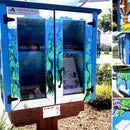Introduction: Starting My Shelter-in-Place Veggie Garden Indoors
My family has been on lockdown for almost 4 weeks and we're down to our last tomato.
I love to garden, but haven't done much in the last few years. Now seems like the perfect time to dust off my trowel and feed my family. My objective is to have fresh produce as soon as possible, and have the process be as easy as possible.
Since I live in California I thought I'd buy plants and get them in the ground early. Unfortunately, all the nurseries are closed and most online suppliers were sold out. After some research I finally found seeds and supplies online. (It's possible that you can still get supplies at places like Home Depot, but that means defying shelter in place restrictions and risking exposure.)
In this Instructable I'll show you my process for getting food plants underway indoors to be ready for planting time. I will assume limited access to supplies and no planting experience.
Step 1: Getting Started
After filling several carts online just to discover a seed company was sold out or not delivering, I finally found one that was still stocked and shipping. I was able to get everything I needed at Ferry Morse. (My dad ordered a week later and got everything he needed, too) I'd never purchased from them before and had a good experience. I even had a question and customer service got back to me quickly in a helpful, friendly manner.
Requirement 1:
I only want to grow plants that can be eaten: Vegetables, and herbs for seasoning food
Requirement 2:
Must be easy. Life is hard enough right now. I want plants that practically grow themselves.
Requirement 3:
Plants need to be able to grow in limited space. Tall is fine, wide can be a problem.
Website: https://ferrymorse.com
Step 2: Plan Before You Buy
Decide on your own requirements, and whether your needs are different than the ones I listed in the previous step.
Then decide where your baby plants will ultimately be transplanted when the weather warms. If you have space constraints like I do, think outside the box (literally!). I took a walk around my house to see exactly what I have to work with. I was actually surprised at what I found when I decided I didn't need a traditional geometric garden. Remember, the objective is to put food on the table. Make note of which spots get full sun, partial shade, etc.
A major concern for me is availability of water. It won't rain during the summer months, and I only have one water source in the front yard and one in the back. I have no way to get water to either side. Even if you don't have a yard, look to other spots to see what you do have: Sunny windows, a patio or balcony, etc. Many food plants can be grown in containers.
As you see from my photos, I have a planter box, a few large pots, and some spots between shrubbery. I can get water to these areas and they all get sun. Some are in my front yard. It's okay to plant in front :-)
I can now plan out approximately how many plants I can grow and where they'll go. For example: I'll use 1 pot for mint, which spreads when not contained, and bush cherry tomatoes in the other 2 pots. The raised bed will get my large tomato plants and some peppers. Zucchini can go between shrubs.
Step 3: Choose Seeds
It's time to choose and buy seeds.
First rule: Only grow what you like to eat!
Next, decide what you want to grow. I chose 4 vegetables (tomato, red pepper, zucchini, string beans) and 4 herbs. I love tomatoes, so I picked a few varieties: 1 cherry, 2 heirloom, 1 early. These each have different growing needs, so they'll be planted where they'll grow best, not necessarily together.
If you don't know what you want, start with a category to narrow your choices. Some categories include: easy to grow, container gardens, pest resistant, etc.
If you know what you want to grow, start with any one vegetable. You will be able to sort the varieties by your needs. Whatever is left to choose from is what you'll need to check individually. When you click on each variety, you'll get details on how, where, and when it grows. Find the best one for you.
Continue this process for each vegetable, herb, or fruit you want.
Note on fruits:I don't grow fruits from seed because I have too much trouble keeping critters from stealing before I can harvest anything. Also, except for strawberries, there aren't a lot of choices for small gardens. Though if you have a lot of room, melons are great.
Step 4: My Favorite Dirt
When you order seeds, the only other thing you have to have is growing medium, or dirt. My favorite choice for ease of indoor growing and low cost is Jiffy Pellets. While you can get all kinds of fancy growing kits, I buy just packs of pellets. You'll see what I got in the next step. I bought 3 packs.
Step 5: What I Bought
If my garden sounds good to you, here's what I bought.
(I overbought for my space, so I plan to share my seedlings when they sprout.)
******************************************
8102 Tomato Early Girl Hybrid Seed
7089 Bean Garden Tendergreen Improved (Bush) HEIRLOOM Seed
2447 Rosemary (Sow Easy) Seed
9015 Peppermint Seed
7348 Sage Broad Leaf Seed
2412 Cilantro Coriander (Sow Easy) Seed
1435 Organic Pepper California Wonder Seed
7680 Squash Dark Green Zucchini Seed
4164 Tomato Box Car Willie HEIRLOOM Seed
2168 Tomato Brandywine Pink Fruited HEIRLOOM Seed
8105 Tomato Supersweet 100 Hybrid Seed
J4R25 Jiffy Peat Pellet Refill 25 Pack, 42mm Pellets
Step 6: Greenhouse
While you're waiting for your seed order, find what you need for a makeshift green house. Also, locate a spot indoors to keep it while the seeds germinate and grow.
The greenhouse is comprised of 2 easy parts that most of us have around the house. First, you need any kind of plastic watertight bin, bucket or container. Any size is fine, but if your container is too small for the number of plants you'll be growing, you may need more than one. If you don't think you have a container, look again. Anything plastic you have stuff stored in is usable. Just put your stuff in a box for a month or two until your seedlings can go outside. No lid is needed, but if you do have a clear lid, you won't need item 2.
Second, the plastic box will get covered with clear plastic. Saran Wrap, Press and Seal, or even a plastic bag is good. Clear plastic bags can be cut open to be larger, and they can be taped together if needed.
If you can't find a bin, use a lined cooking tray. You'll have to water more often to keep the pellets moist.
I'm using two fairly large bins for about 75 pellets with Press and Seal on top. One of my bins is a never-been-used litter box.
Step 7: Get Ready to Plant
When your order arrives, read the seed packages and make sure you're not starting your seeds too early for your growing zone (also on the package). If you start them too soon they'll outgrow the pellets before they can go outside and you'll have to transplant them into larger pots indoors while you wait. If they're a little late for your growing zone, don't panic. The hot weather will help your seedlings play catch up. Personally, I prefer to start my seeds indoors even if the weather is warm so I can protect the tiny sprouts from becoming snail lunch.
Water the Jiffy Pellets. This is one of my favorite parts :-) Find any watertight container and add a couple of inches of warm water. Then float the pellets. Make sure the side with the hole in the mesh faces up. They will magically expand into little growing pots over about 10 minutes.
While the pellets are expanding get a permanent marker, tape or paper to write on, a toothpick, and the container or tray your plants will germinate in.
Step 8: Plant Your Seeds
Open your first seed packet. Make a label for this plant and tape it to the inside of the greenhouse where the plants will grow. I put mine in rows in from of the label.
For each plant:
Take one Jiffy pot out of the water.
Make a hole in the top with a pencil eraser, marker, or finger. Most seeds are planted 1/4", but some are deeper. Check the package for the right depth of the hole. Approximate depth is fine. Sprouts will find their way.
Drop 2-3 seeds in the hole. (No more than 2 for large seeds, like beans)
Separate them with the toothpick if necessary.
Push soil over the hole to fill it in.
Gently press.
Put it in the labeled spot in your "greenhouse" bucket/bin.
Repeat for every plant. You may have a lot of seeds leftover. You can save them for next year or share them. Or plant lots of extras and give away plants.
Note: Save empty seed packets. They have valuable info.
Step 9: Seal the Greenhouse
Cover the top of your bin with plastic. If it doesn't stay on, use tape, but leave an opening to check moisture levels and add water as needed.
Put the greenhouse in it's place. It doesn't have to be particularly warm since it will be indoors, but seedlings will grow faster with warmer temperatures. A cold garage isn't a good idea, but anywhere humans are comfortable will be fine.
Step 10: Check Water
The plants will germinate and grow best if the pellet pots are moist, but not soaked. They shouldn't be dripping if you pick them up. They will look light brown if they're too dry. If they are too dry, add water and wait until it's soaked up. If they're too wet, leave the lid off until the excess has evaporated.
Check water daily.
Step 11: Baby Plants
Depending on the plants and temperature, most seeds will germinate in 4-10 days. Again, check the packet for each variety. When a few of your plants have sprouted, move your greenhouse to a sunny spot during the day. After a few days you can remove the plastic cover.
Check every day to make sure the soil is moist. If they need water either pour some into the tray and let it soak up or use a spray bottle to water gently.
Check the seed packets to see how big they should be when it's time to transplant into larger containers, or outdoors if the weather is warm enough.
Step 12: Thinning
As painful as it may be, you have to thin the herd. Ultimately, there should be only 1 plant per pot. Choose the strongest, healthiest looking seedling in each pot and either cut or pinch the rest. Never pull the ones you don't want. That would disturb the roots of the plant you're saving.
When your seedings and the weather meet the specifications on the seed packets, transplant them into their summer homes! Good luck with your food garden and stay safe!

Participated in the
Indoor Plants Challenge













